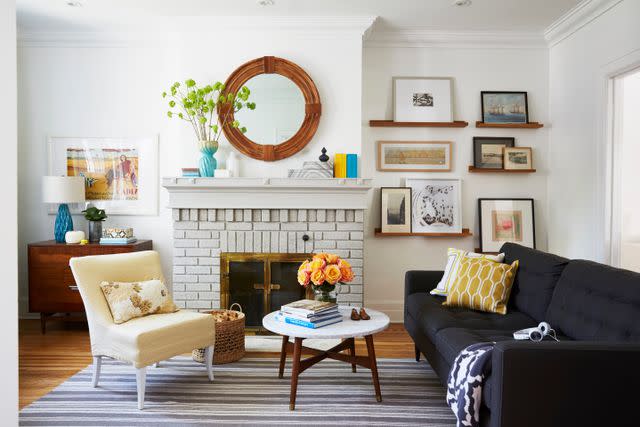How to Flatten a Rug: 6 Proven Techniques
Avoid slips and spills by flattening your area rugs using these techniques.
Searching for the perfect area rug that adds a pop of color, connects multiple design elements in a room, or defines a sitting area can take a lot of time and effort, so once you find one that works for your space all you want to do is unroll it and enjoy. Unfortunately, unruly edges and corners can ruin the fun. When rugs won’t flatten out, they can become tripping and safety hazards, prevent robot vacuums from working properly, and expose your floors to spills, knicks, and scrapes. So how do you flatten a rug? Here are a few tips and tricks, from weighing it down to calling in the professionals, that can help with any area rug.

Stacey Brandford
1. Let It Rest
Often the fibers of a rug just need to relax after being unrolled, especially if the area rug has been in its packaging for a long period of time, say from traveling from a warehouse to your front door. If the edges curl upward, lay the rug on a flat, hard surface and fold the edges slightly under. Leave the rug alone for a few days and let the fibers stretch out.
2. Flip It Over
If the edges are curling under, flip the area rug over and let gravity do its job. To speed up the process, once it’s flipped you can curl the corners under to help train them. For a plush rug, curling the corners should do the trick. If it still won’t lay flat, roll the area rug in the opposite direction, with the backing facing out, and secure it with twine or a belt. Leave it in this position for a few days to reverse the rug’s curl pattern.
3. Weight It Down
If these moves don’t do the trick, use the tried-and-true method of weighing down the edges of the rug. Heavy objects, such as books, a piece of furniture, or moving boxes work great to help force the fibers to flatten out.
4. Apply Heat
If your area rug has creases from being folded, heat is a good option to flatten it out. There are a few different methods you can use that involve heat. On a sunny day, try laying the area rug on the ground in direct sunlight. The heat from the sun and the asphalt or concrete below will help release any creases or wrinkles. If you’re trying the reverse roll method, set the roll outside in the sun to let the heat speed up the flattening process.
If you don’t have a clean outdoor area, try using a hair dryer or a clothes iron to flatten a rug. The key to both methods is to keep the appliances moving to prevent damage. Set the hair dryer to a low heat setting, hold it 6 to 9 inches away from the backside of the rug, and continually sweep over the fibers to help remove creases. If using an iron, use a low setting and place a barrier (kraft paper or a thin towel) between the rug and the iron, then continuously move the iron over the corners and creases.
5. Get a Grip
There are lots of corner tools, weights, and adhesive grippers available at hardware stores and online that promise to help hold down rug edges. For an economical option, apply painters tape or two-sided rug tape around the edges to train the rug to lay flat. Remove the tape after one to two days.
Corner grips serve double duty by weighing the corners of a rug down and keeping it from sliding across the floor. These come in a variety of sizes, shapes, and price points. When choosing an adhesive, make sure to check the materials list to avoid choosing a material that could damage hardwood or natural stone.
6. Call a Professional
When dealing with vintage, expensive, or fragile rugs, it might be best to call a professional. They can steam the fibers or stretch the rug to remove creases and flatten the corners.
For more Better Homes & Gardens news, make sure to sign up for our newsletter!
Read the original article on Better Homes & Gardens.

